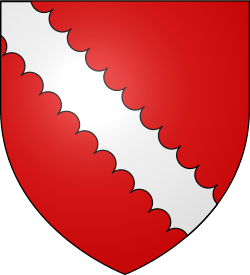John de Fenton
Sir John de Fenton was a 14th-century Scottish noble.

Coat of Arms of Fenton of that Ilk
He was the son of William de Fenton, Lord of Baikie and Beaufort and Cecilia Bisset, the co-heiress of John Bisset, Lord of Lovat.[1] John succeeded to his father's estates.[2]
John campaigned with King Robert I of Scotland against the William, Earl of Ross in 1308 and was a witness at the submission of William, Earl of Ross to King Robert I.[3] He was at the Scottish parliament of 1309 at St. Andrews. Fenton signed the Declaration of Arbroath in 1320 and attached his seal. His seal however is no longer attached to the document.
Citations
- Society of Antiquaries of Scotland, p.436
- People of Medieval Scotland - John of Fenton, son of William of Fenton
- Barron, p.349.
gollark: Wait, if putting something in brackets will tupulifise it, how do you go around writing stuff like `(1 + 2) * 3`?
gollark: So... that 1 returned there... is *that* a tuple?
gollark: Yes, which is pointless.
gollark: Making b be a 1-tuple adds nothing.
gollark: ```haskella = () -- empty/0-tupleb = (()) -- is not 1-tuple, just () - 1-tuple doesn't really add anythingc = ((), ()) -- 2-tuple of 0-tuples```
References
- Barron, E. M., "The Scottish War of Independence", Second Edition. 1934
- Proceedings of the Society of Antiquaries of Scotland, Volume 8; 1871.
This article is issued from Wikipedia. The text is licensed under Creative Commons - Attribution - Sharealike. Additional terms may apply for the media files.